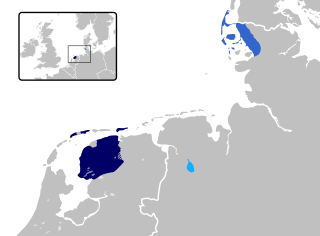
The Frisian languages are a closely related group of West Germanic languages, spoken by about 500,000 Frisian people, who live on the southern fringes of the North Sea in the Netherlands and Germany. The Frisian languages are the closest living language group to the Anglic languages; the two groups make up the Anglo-Frisian languages group and together with the Low German dialects these form the North Sea Germanic languages. However, modern English and Frisian are not mutually intelligible, nor are Frisian languages intelligible among themselves, due to independent linguistic innovations and foreign influences.

The Germanic languages are a branch of the Indo-European language family spoken natively by a population of about 515 million people mainly in Europe, North America, Oceania and Southern Africa. The most widely spoken Germanic language, English, is also the world's most widely spoken language with an estimated 2 billion speakers. All Germanic languages are derived from Proto-Germanic, spoken in Iron Age Scandinavia.
The Goidelic or Gaelic languages form one of the two groups of Insular Celtic languages, the other being the Brittonic languages.
Norse is a demonym for Norsemen, a medieval North Germanic ethnolinguistic group ancestral to modern Scandinavians, defined as speakers of Old Norse from about the 9th to the 13th centuries.
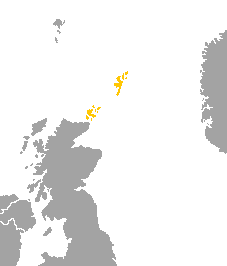
Norn is an extinct North Germanic language that was spoken in the Northern Isles off the north coast of mainland Scotland and in Caithness in the far north of the Scottish mainland. After Orkney and Shetland were pledged to Scotland by Norway in 1468–69, it was gradually replaced by Scots. Norn is thought to have become extinct in 1850, after the death of Walter Sutherland, the language's last known speaker, though there are claims the language persisted as late as the 20th century.
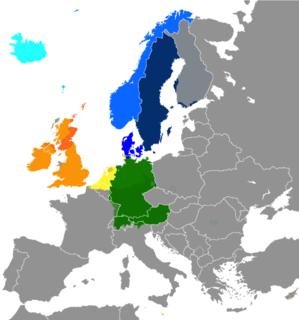
The West Germanic languages constitute the largest of the three branches of the Germanic family of languages.
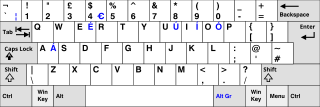
English, in various dialects, is the most widely spoken language of the United Kingdom, but a number of regional languages are also spoken. There are 14 indigenous languages used across the British Isles: 5 Celtic, 3 Germanic, 3 Romance, and 3 sign languages: 2 Banzsl and 1 Francosign language. There are also many languages spoken by people who arrived more recently in the British Isles, mainly within inner city areas; these languages are mainly from continental Europe and South Asia.
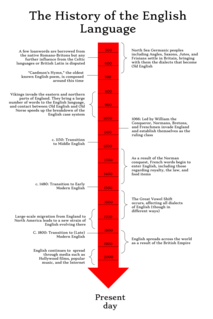
English is a West Germanic language that originated from Anglo-Frisian languages brought to Britain in the mid 5th to 7th centuries AD by Anglo-Saxon migrants from what is now northwest Germany, southern Denmark and the Netherlands. The Anglo-Saxons settled in the British Isles from the mid-5th century and came to dominate the bulk of southern Great Britain. Their language, now called Old English, originated as a group of Anglo-Frisian languages which were spoken, at least by the settlers, in England and southern and eastern Scotland in the early Middle Ages, displacing the Celtic languages that had previously been dominant. Old English reflected the varied origins of the Anglo-Saxon kingdoms established in different parts of Britain. The Late West Saxon dialect eventually became dominant. A significant subsequent influence on the shaping of Old English came from contact with the North Germanic languages spoken by the Scandinavian Vikings who conquered and colonized parts of Britain during the 8th and 9th centuries, which led to much lexical borrowing and grammatical simplification. The Anglian dialects had a greater influence on Middle English.

The history of the Scots language refers to how Anglic varieties spoken in parts of Scotland developed into modern Scots.
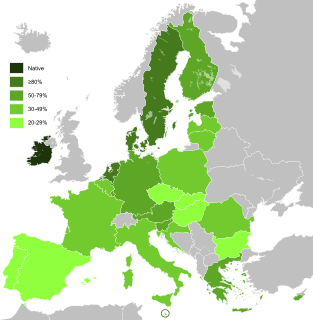
The English language in Europe, as a native language, is mainly spoken in the United Kingdom and Ireland. Outside of these states, it has official status in Malta, the Crown dependencies, Gibraltar and the Sovereign Base Areas of Akrotiri and Dhekelia. In the Kingdom of the Netherlands, English has an official status as a regional language on the isles of Saba and Sint Eustatius. In other parts of Europe, English is spoken mainly by those who have learnt it as a second language, but also, to a lesser extent, natively by some expatriates from some countries in the English-speaking world.

The Britons, also known as Celtic Britons or Ancient Britons were the Celtic people who inhabited Great Britain from at least the British Iron Age and into the Middle Ages, at which point they diverged into the Welsh, Cornish and Bretons. They spoke the Common Brittonic language, the ancestor of the modern Brittonic languages.

The Anglo-Frisian languages are the Anglic and Frisian varieties of West Germanic languages.
Galwegian Gaelic is an extinct dialect of Scottish Gaelic formerly spoken in southwest Scotland. It was spoken by the people of Galloway and Carrick until the early modern period. Little has survived of the dialect, so that its exact relationship with other Gaelic language is uncertain.
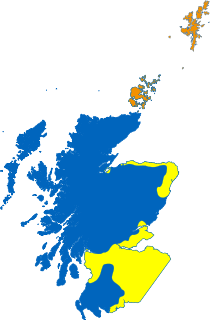
Early Scots was the emerging literary language of the Northern Middle English speaking parts of Scotland in the period before 1450. The northern forms of Middle English descended from Northumbrian Old English. During this period, speakers referred to the language as "English".

The languages of Scotland are the languages spoken or once spoken in Scotland. Each of the numerous languages spoken in Scotland during its recorded linguistic history falls into either the Germanic or Celtic language families. The classification of the Pictish language was once controversial, but it is now generally considered a Celtic language. Today, the main language spoken in Scotland is English, while Scots and Scottish Gaelic are minority languages. The dialect of English spoken in Scotland is referred to as Scottish English.
A nuggle, njuggle, or neugle, is a mythical water horse of primarily Shetland folklore where it is also referred to as a shoepultie or shoopiltee on some parts of the islands. A nocturnal creature that is always of a male gender, there are occasional fleeting mentions of him connected with the Orkney islands but he is more frequently associated with the rivers, streams and lochs of Shetland. He is easily recognised by his distinctive wheel-like tail and, unlike his evil counterparts the each-uisge or the nuckelavee, has a fairly gentle disposition being more prone to playing pranks and making mischief rather than having malicious intents.

The modern names of Scottish islands stem from two main influences. There are many names that derive from the Scottish Gaelic language in the Hebrides and Firth of Clyde. In the Northern Isles most place names have a Norse origin. There are also some island place names that originate from three other influences, including a limited number that are essentially English language names, a few that are of Brittonic origin and some of an unknown origin that may represent a pre-Celtic language. These islands have all been occupied by the speakers of at least three and in many cases four or more languages since the Iron Age, and many of the names of these islands have more than one possible meaning as a result.














